Postal Cards - Issue of 1879 - Plate II: Alfonso XII
Tarjetas Postales - Emisión de 1879 - Plancha II: Alfonso XII
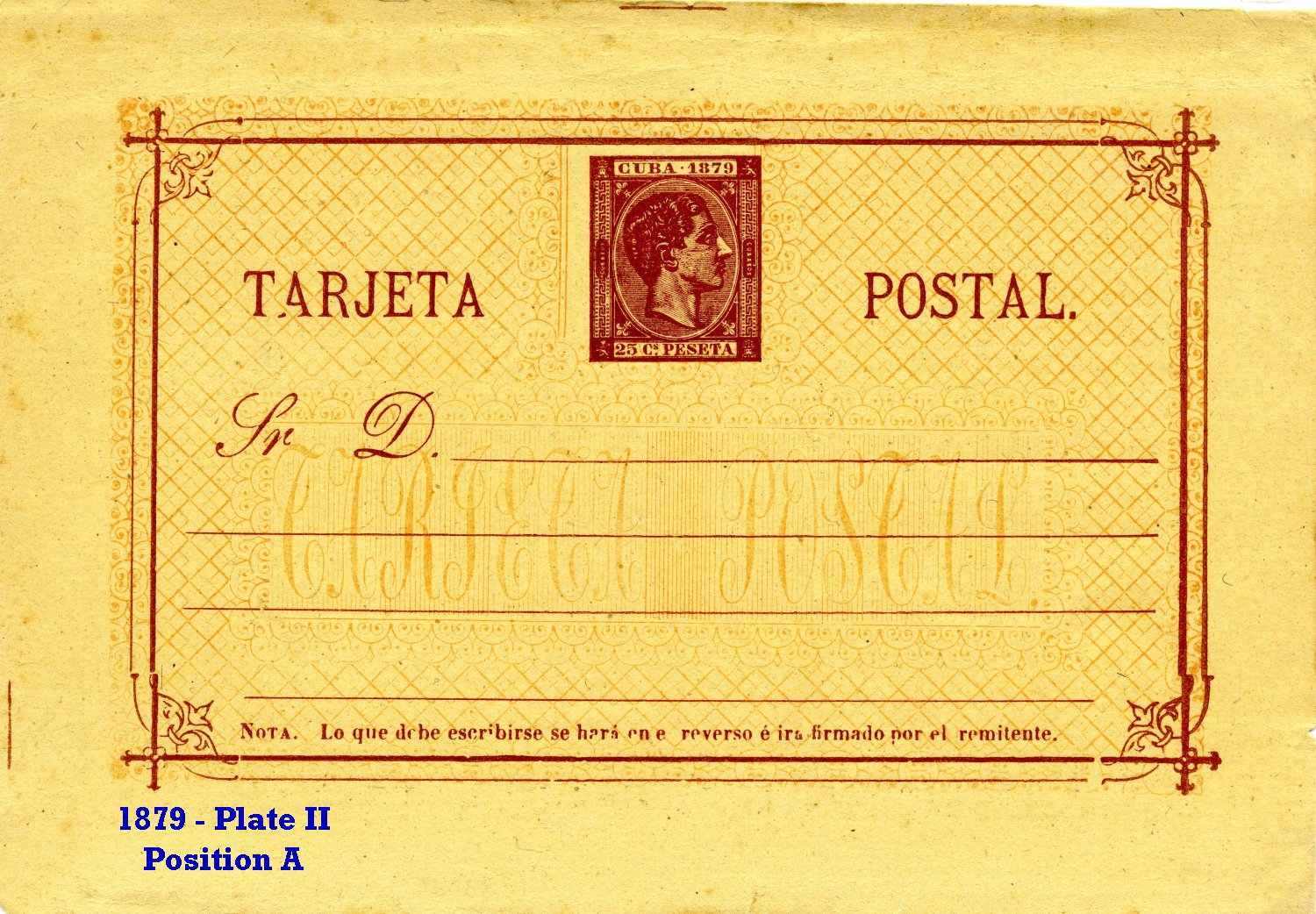
1879 — Plate II, Position "A"
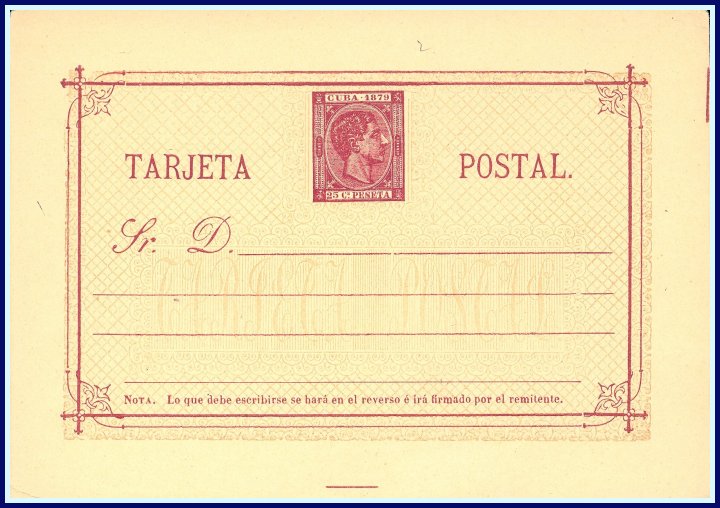
1879 — Plate II, Position "F"
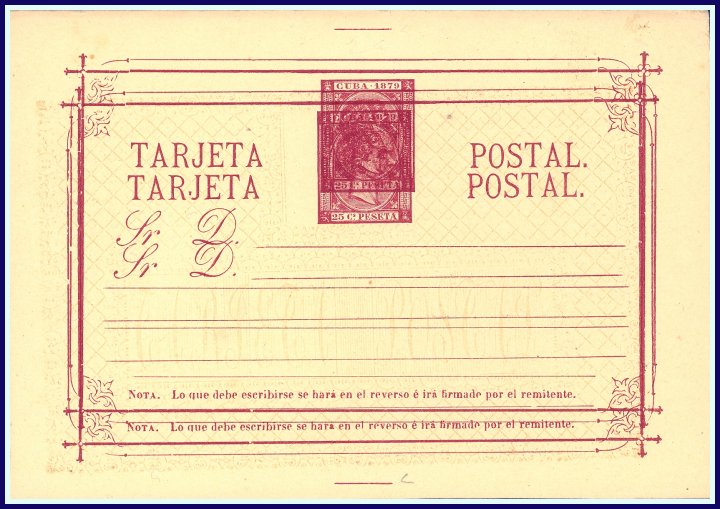
1879 — Plate II, Position "Q" — Double printing / doble impresión
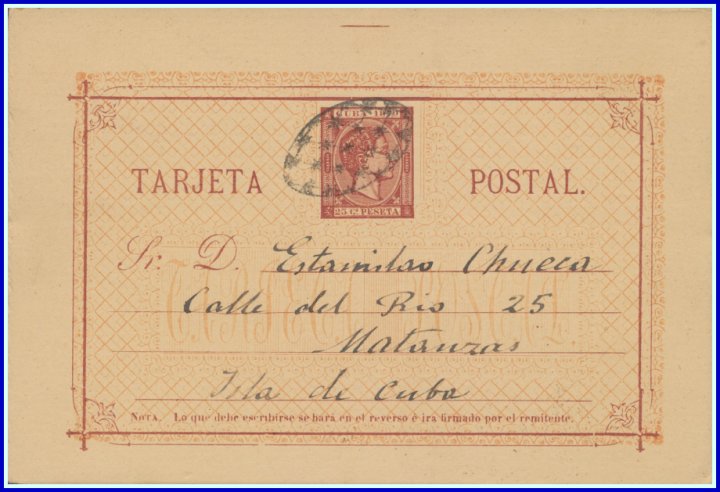
1879 — Plate II, Position "R" — Used to Matanzas - Courtesy of Octavio Cabrera
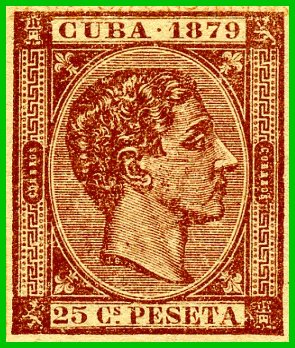
1879 Indicium
| Technical Details / Detalles Técnicos |
| Issue Date / Fecha de Emisión |
1879 |
| Size / Tamaño |
144 x 96 mm |
| Denomination / Denominación |
25 céntimos de peseta |
Printing
Impresión |
Printed by typography for the Fábrica Nacional de Sello
Impresa en tipografía por la Fábrica Nacional de Sello |
Print and Paper Color
Color Impresión y Papel |
reddish brown & orange on cream
castaño rojizo & naranja s. crema |
Period of Circulation
Periodo de Circulación |
1879 |

1879 Plate II Postal Cards
1879 - Alfonso XII - 25 céntimos de peseta
UPSS No. 2 — Plate II / Plancha II |
| Plate Pos. |
Edifil # |
Description of Plate Positions
The placement in the printing plate of the cards described below is not known because no multiple pieces of this plate
have survived; therefore, the plate positions have been assigned a letter to differentiate them.
Descripción de las posiciones de la plancha
La posición en la plancha de las tarjetas descritas a continuación no se ha podido determinar debido a que
no ha sobrevivido ninguna pieza múltiple, de manera que las posiciones se han designado con una letra para diferenciarlas. |
↓ ↓ Clicking on the Plate Position link displays a complete image of the corresponding card.
↓ ↓ Pulsando en el número de cada posición despliega una imagen completa de la tarjeta correspondiente. |
| |
|
"r" in Sr TYPE I & II / "r" en Sr TIPO I & II
Position A in Plate II is the only position with a Type II "r" in Sr.
La posición 1 de la Plancha II es la única con una "r" de Sr Tipo II. |
| A |
2A |
Type II r in Sr, no period after Sr, and break in the first "A" of TARJETA.
Tipo II de la r en Sr, sin punto después de Sr y rotura de la primera "A" de TARJETA. |
| B |
2B |
"esbribirse" in place of escribirse, in the note
"esbribirse" en lugar de escribirse, en la nota |
| C |
2Bca |
Small "á" of both hará and irá and
two breaks in the right thick frame line to the right of the second address line.
"á" de hará y irá pequeña, de 1 mm de alto y
dos roturas en el margen vertical grueso a la derecha de la segunda línea de la dirección. |
| D |
— |
Break 7mm from the beginning of the first address line and
6 - 8 breaks in the bottom thick frame line.
Rotura al principio de la primera línea de la dirrección y 6 - 8 roturas en el marco grueso inferior. |
| E |
— |
Break in the first address line below the indicia and small "á" of both hará and irá.
Primera línea de la dirrección rota, debajo del sello y
"á" de hará y irá pequeña, de 1 mm de alto. |
| F |
— |
Position not yet identified
Posición todavía no identificada.
What was formerly classified as Plate II, Position F, has been shown to be Plate I, Position 3. |
| G |
— |
"ira" instead of irá.
"ira" sin acento. |
| H |
2Bce |
Dot of "i" of remitente displaced to the right; the upper left end piece is missing on the curved portion
of the
thin frame line; break in the upper thin frame line..
"i" de remitente con el punto desplazado a la derecha. |
| I |
— |
No period behind the "D" and short first address line at the start.
Sin punto después de "D". |
| J |
— |
Missing 6 mm section of left thin frame line towards the top.
Rotura de 6 mm en la línea fina del marco vertical izquierdo en su parte superior. |
| K |
— |
Break in the bottom thick frame line below the "q" in que and
small "á" of hará.
Rotura en la línea gruesa del marco inferior debajo de la "q" in que y
"á" de hará pequeña, de 1 mm de alto. |
| L |
2Bch |
There is a missing "i" and large "b" in escribirse (1.5 mm).
"b" grande de 1,5 mm en escribirse. |
| M |
2Bci |
"o" is broken in Nota, it lacks the left half and small "á" of both hará and irá
"o" in nota rota, le falta la mitad izquierda y "á" de hará y irá pequeña, de 1 mm de alto. |
| N |
— |
Second "A" of TARJETA is smaller and broken 'N' in Nota and "L" in Lo
Segunda "A" de TARJETA, más pequeña y roturas en la "N" de Nota y la "L" de Lo. |
| O |
— |
Missing accent and small "á" of hará and break in the thick frame line below the "el" of el reverso.
"á" de hará pequeña, de 1 mm de alto. |
| P |
— |
Top of letter "L" in Lo que debe is broken off and
Break in the thin frame line below "el" of el reverso and small "á" of hará.
"L" de Lo que debe, de la misma altura que las minúsculas y
rotura en la línea fina del marco debajo de "el" de el reverso.
"á" de hará pequeña, de 1 mm de alto. |
| Q |
— |
No period after Sr; break in the thick bottom frame line below the "sc" in escribirse and
two breaks in the left thin frame line to the left of Sr and TARJETA
Sin punto después de Sr, rotura en la línea gruesa del marco debajo de "sc" en escribirse y
dos roturas en la línea fina del marco vertical izquierdo a la altura de Sr y TARJETA. |
| R |
— |
Lower thin frame line is broken below the "sc" in escribirse. The second address line dips below the D. The first address line is about 2 mm short on both ends.
La línea fina de la parte inferior del marco esta rota bajo la "sc" de escribirse. La segunda línea de la dirección esta doblada hacia abajo de la D. La primera línea de la dirección es 2 mm más corta en ambos lados. |
| S |
— |
The period behind remitente is raised and flat. The bottom right ornament has a flattened end piece.
El punto detras "remitente" esta elevado y elongado. El adorno en la parte inferior derecha esta aplastado.- |
| T |
— |
First address line is 76mm with breaks under "Cs" and first "E" of PESETA
La primera línea de la dirección es de 76 mm y tiene roturas debajo de Cs y de la primera E de PESETA. |
Double impressions (printer's waste--not errors)
Impresiones dobles (desechos de imprenta o maculatura--no son errores) |
| — |
— |
Double printing without the background
Doble impresión, sin fondo
Position Q |





